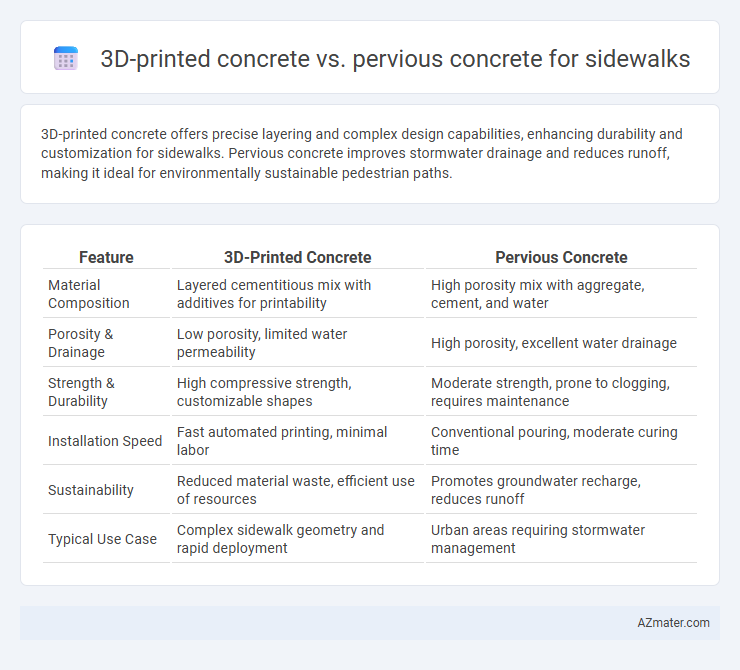3D-printed concrete offers precise layering and complex design capabilities, enhancing durability and customization for sidewalks. Pervious concrete improves stormwater drainage and reduces runoff, making it ideal for environmentally sustainable pedestrian paths.
Table of Comparison
| Feature | 3D-Printed Concrete | Pervious Concrete |
|---|---|---|
| Material Composition | Layered cementitious mix with additives for printability | High porosity mix with aggregate, cement, and water |
| Porosity & Drainage | Low porosity, limited water permeability | High porosity, excellent water drainage |
| Strength & Durability | High compressive strength, customizable shapes | Moderate strength, prone to clogging, requires maintenance |
| Installation Speed | Fast automated printing, minimal labor | Conventional pouring, moderate curing time |
| Sustainability | Reduced material waste, efficient use of resources | Promotes groundwater recharge, reduces runoff |
| Typical Use Case | Complex sidewalk geometry and rapid deployment | Urban areas requiring stormwater management |
Introduction: Innovations in Concrete for Sidewalks
3D-printed concrete revolutionizes sidewalk construction through precise layering and complex geometric capabilities, enabling faster installation with reduced labor and waste. Pervious concrete offers enhanced stormwater management by allowing water infiltration, reducing surface runoff and promoting groundwater recharge. Both materials represent significant advancements in sustainable and resilient urban infrastructure design.
Overview of 3D-Printed Concrete Technology
3D-printed concrete technology utilizes automated layering techniques driven by digital design files, enabling precise and customizable construction of sidewalks with enhanced structural complexity and reduced material waste. This method allows for rapid on-site production, significantly decreasing labor costs and construction time compared to traditional pervious concrete that relies on manual pouring and curing processes. The technology supports innovative geometric patterns and embedded functional elements, fostering sustainable urban infrastructure with improved durability and permeability tailored to specific environmental conditions.
Understanding Pervious Concrete and Its Features
Pervious concrete is engineered to allow water infiltration through its porous structure, reducing stormwater runoff and promoting groundwater recharge. Its composition typically includes larger aggregate sizes with little to no fine aggregates, creating interconnected voids that enhance permeability while maintaining adequate strength for sidewalk applications. Compared to 3D-printed concrete, pervious concrete excels in managing urban water sustainability, making it an environmentally beneficial choice for permeable sidewalks.
Material Composition: 3D-Printed vs Pervious Concrete
3D-printed concrete typically consists of a high-performance cementitious mix with fine aggregates, admixtures for improved flowability, and rapid setting agents to enable layer-by-layer deposition, optimizing strength and precision in complex shapes. Pervious concrete, by contrast, incorporates coarse aggregates, minimal fine aggregates, and a higher void ratio, facilitating water permeability through an interconnected pore structure while maintaining sufficient structural integrity for pedestrian use. The primary material difference lies in 3D-printed concrete's tailored mix for extrudability and strength versus pervious concrete's formulation for permeability and stormwater management.
Installation Process Comparison
3D-printed concrete offers a highly automated installation process, reducing labor costs and construction time through precise layer-by-layer deposition controlled by computer models. In contrast, pervious concrete requires traditional mixing, pouring, and manual finishing techniques, often demanding skilled labor to maintain adequate porosity and drainage properties. The 3D printing method minimizes material waste and enables complex design geometries, while pervious concrete installation relies on conventional equipment with potential variability in consistency and compaction quality.
Durability and Lifespan: Which Lasts Longer?
3D-printed concrete offers enhanced durability due to its precise layering and reduced human error, resulting in a lifespan often exceeding 50 years with minimal maintenance. Pervious concrete, designed for water permeability, typically has a shorter lifespan of around 20-25 years because its porous structure is more susceptible to wear and clogging. For sidewalks requiring long-term durability and load-bearing capacity, 3D-printed concrete generally provides a longer-lasting solution compared to pervious concrete.
Sustainability and Environmental Impact
3D-printed concrete offers enhanced material efficiency and reduced waste compared to traditional pervious concrete, lowering the carbon footprint of sidewalk construction through precise layering and reduced formwork. Pervious concrete facilitates stormwater infiltration, mitigating runoff and promoting groundwater recharge, thereby supporting sustainable urban drainage systems. While 3D-printed concrete reduces resource consumption during fabrication, pervious concrete contributes directly to environmental health by improving water management and reducing urban heat island effects.
Cost Analysis: Initial and Long-Term Expenses
3D-printed concrete sidewalks often have higher initial costs due to advanced technology and specialized equipment, but they benefit from reduced labor expenses and faster installation times. Pervious concrete typically incurs lower upfront costs with conventional mixing and pouring methods but may require more frequent maintenance and repairs over time due to wear and clogging issues. Long-term expenses favor 3D-printed concrete because of its enhanced durability, reduced maintenance needs, and precise material usage that minimizes waste.
Maintenance Requirements and Challenges
3D-printed concrete sidewalks require minimal maintenance due to their precise layering and reduced material waste, but challenges include ensuring structural integrity and preventing cracking over time. Pervious concrete offers excellent water drainage and reduces runoff, yet demands regular cleaning to prevent clogging and maintain permeability, posing higher ongoing upkeep. Both materials face challenges related to environmental exposure, but 3D-printed concrete benefits from advanced formulation techniques that enhance durability while pervious concrete requires vigilant maintenance to sustain functionality.
Suitability and Recommendations for Sidewalk Applications
3D-printed concrete offers superior customization and rapid construction advantages, making it suitable for complex sidewalk designs with precise contours and reduced labor costs. Pervious concrete excels at stormwater management by allowing water infiltration, reducing runoff, and preventing urban flooding, which is critical for sidewalk applications in areas with high rainfall or environmental regulations. For sidewalks requiring intricate shapes and quick installation, 3D-printed concrete is recommended, while pervious concrete is preferred in eco-sensitive zones where drainage and sustainability are priorities.

Infographic: 3D-printed concrete vs Pervious concrete for Sidewalk
 azmater.com
azmater.com